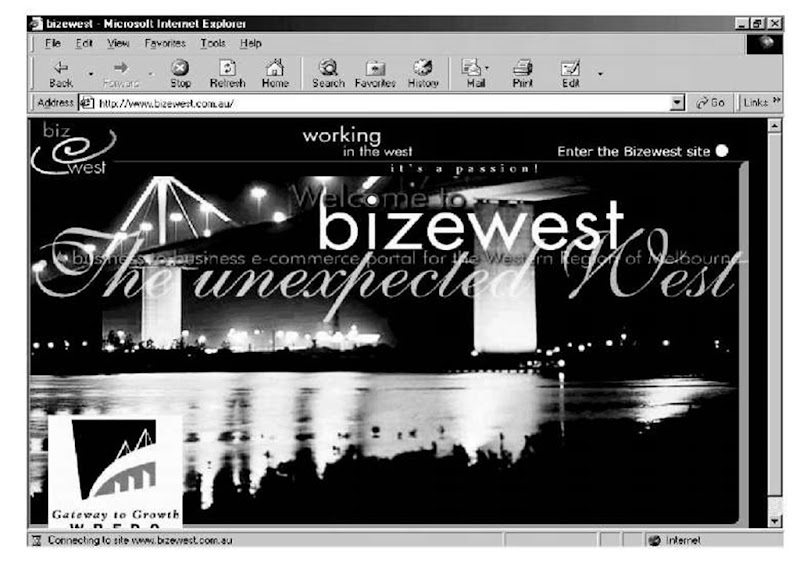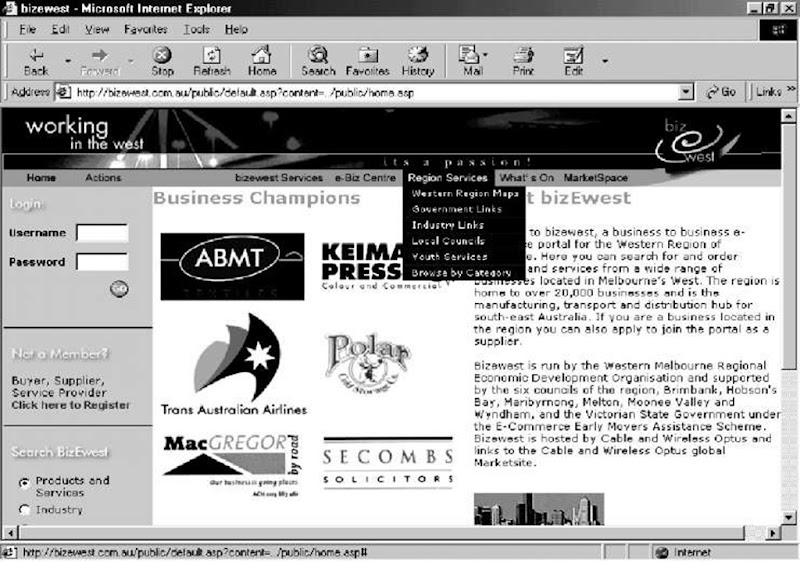INTRODUCTION
In June 2000, the Western Region Economic Development Organisation (WREDO), a not-for-profit organisation sponsored by the six municipalities that make up the western region of Melbourne, received a state government grant for a project to set up a business-to-business portal. The project was to create a “horizontal portal”—BIZEWEST—that would enable small to medium enterprises (SMEs) in Melbourne’s west to engage in an increased number of e-commerce transactions with each other. The western region of Melbourne contains around 20,000 businesses, and is regarded as the manufacturing, transport, and distribution hub of South-eastern Australia (Tatnall, Burgess, & Singh, 2004). Traditionally, this region had encompassed much of the industry in metropolitan Melbourne.
BACKGROUND
Australia is a federation of six states and two territories. The states are segmented into smaller regions, or communities of interest, to deliver base-level services to the people. These services include things like the administration of building standards, the policing of minor by-laws, the provision of garbage collection services, and ensuring the welfare of the aged. Much of the revenue of local government comes from the imposition of rates and charges on property owners within the municipality, but a significant part of the income comes in the form of grants from the other two levels of government. Local government is extremely vulnerable in that any administration can be dismissed by a state local government minister. Unlike the two upper levels of government, the parliament or council of local government is composed of politicians who are only part time and are not paid a salary. However, they are paid allowances to compensate them for expenses incurred whilst performing their duties (Pliaskin, 2004).
Research Design
A research project to investigate adoption of the portal (Tatnall & Burgess, 2002) consisted of several stages, beginning with interviews of the “business champions” and other important players identified by WREDO. The second stage involved returning to the businesses interviewed earlier and checking whether things are progressing as they thought they would, and whether they had made any changes to the way they did business resulting from their use of the portal. The final stage, which is the subject of this chapter, collected historical data about the portal’s development, operation, and final demise.
DESIGNING THE PORTAL
BIZEWEST was a regional, inwardly focussed, horizontal business-to-business Web portal based in the western suburbs of Melbourne in Australia that was established in May 2001 and ceased operations in June 2003. It was charged with enabling small- to medium-sized businesses within that region to take advantage of e-commerce opportunities, and to facilitate trade between these entities. The portal was established with the assistance of a government grant and was built under the auspices WREDO, a body sponsored by the six municipal authorities within the area and some of the larger businesses operating there. Its role was to foster economic growth and investment in the region, and so the notion of establishing and operating such a Web portal sat with that body quite comfortably (Pliaskin, 2004).
The treasurer of the state of Victoria, John Brumby, announced the establishment of the Victorian E-Commerce Early Movers Scheme, or VEEM, in February 2000 (VEEM, 2000). This scheme offered grants to local government to help it to assist local businesses to adopt emerging technologies. WREDO formulated a proposal and sent it to the Victorian government on behalf of the six municipalities that sponsored it. The application was drawn up in a hurry and in the expectation that it would not be successful (Pliaskin, 2004). The submission included a number of initiatives that, in hindsight, should not have been there. Some of these included a provision for training secondary school information technology students in Web design, a provision for training business people in e-commerce use, and a provision for the establishment of a payment gateway to facilitate electronic payment for goods and services.
In June 2000 WREDO received a grant from the Victorian government to build the BIZEWEST portal. Together, with its own contribution, WREDO had Aus$345,000 to spend, and this seemed to be a large sum of money at the time.
Figure 1. BIZEWEST portal
BUILDING THE PORTAL
There were, however, problems with the design and the hosting of the portal right from the beginning. Tenderers for the project seemed to be more interested in telling WREDO what they should have rather than vice versa. The funds provided for the construction of the portal were subject to time constraints and ultimately, WREDO had to settle for a product that was not exactly what was wanted.
During the building phase of the Web site and immediately after this, there was much publicity surrounding the project. A number of business breakfasts were held where the topic was the BIZEWEST portal, with the keynote speakers talking on the potential benefits of such a facility. The keynote speakers were prominent people with strong associations with the west and with information technology. They created an atmosphere of enthusiasm and expectation for the portal. Things were looking promising and businesses in the region seemed to be embracing the concept.
WREDO also held several successful Web-a-thons at local shopping centres, where secondary school students helped local entrepreneurs to design pages for inclusion on the BIZEWEST site.
PORTAL OPERATIONS
The portal was launched in a blaze of publicity in May 2001, having been well received by the media and by the businesses in the area. The number of businesses in its catchment area grew quite rapidly and even beyond expectations. It was quite apparent, however, that many of the businesses that took advantage of it by posting pages on the site did not have a good grasp of its potential benefits, but only became players in the situation for reasons that were not entirely based on logic. Many entrepreneurs had an unshakeable belief in WREDO, and used this as the rationale behind their becoming involved with the portal project. Others had heard through third parties that it was a good idea and that there was a possibility that they might be left behind if they did not commit to the BIZEWEST portal. The small businesses in the area suffered from a lack of computing expertise, a common problem among such enterprises (Burgess, 2002; Tatnall, 2002).
Patronage of the portal was always extremely disappointing. Judging from the timing and on the sources of entries, it seemed that the “hits” on the site were mostly accidental. (Pliaskin, 2004; Pliaskin & Tatnall, 2005) Even those who elected to choose to display their wares on the portal were reluctant to use it to source goods and services for themselves. The budget for the site had long since been expended, and WREDO found that it did not have the funds to provide the training to users and prospective users that it had hoped that it would be able to do. The cost of hosting the portal site seemed to be incomprehensively high when compared to the costs associated with hosting the main WREDO Web site. There did not appear to be any rationale for this situation.
Up to this point, WREDO had been providing the site free of charge to those who were using it, but it had become apparent that this could not go on. When firms with pages on the site were asked to contribute to the cost of running it most elected not to do so, and this left WREDO with little option but to close the portal in June 2003 (WREDO staff, 2001). Much of the information from the BIZEWEST portal was transferred to the primary WREDO Web site, MelbWest.com. au, and this new part of MelbWest became more like what had been envisaged for the portal in the first instance.
Figure 2. BIZEWEST home page
CONCLUSION
The construction and commission of BIZEWEST had been a brave move but, in that form, was doomed to failure (Tat-nall & Pliaskin, 2005). Time had proven that it had been overambitious in its scope and that something a little more conservative would have been better. At the same time, a similar portal had been successfully built in Bendigo, a major rural city in central Victoria, also under the VEEM scheme. This had been a success. The Bendigo site had been treated as a prototype with only seven firms involved. At one stage, the possibility of sharing resources between the two projects had been mooted, but this had never come to fruition (Pliaskin, 2004).
Even though BIZEWEST had stumbled at the last hurdle, the project should not be considered a failure as it had enabled some positive outcomes for e-commerce in general and the western region of Melbourne in particular. Because of the existence of the portal, some secondary students from the western suburbs of Melbourne were trained to work in participating businesses using the latest e-business technologies. There was a growth in the use of emerging technologies by businesses, as evidenced by participation in the project rising from 25 registrations in May of 2001 to 180 by December 2001. A model was established for the development of regional Web portals for business-to-business electronic commerce. This model is capable of being replicated in other regions. An e-commerce toolkit for small- to medium-sized businesses was developed. In conjunction with the development of the portal, and because of its introduction, WREDO was able to compile a regional register of 11,000 local businesses. This register was incorporated into the BIZEWEST Web site in December of 2001.
WREDO was itself coming under heavy financial pressure, and in late 2004 its board of directors decided that it had come to the end of its useful life. The organization ceased operations early in 2005. The chief executive officer of WREDO subsequently took up a position with Victoria University, an institution based in the western suburbs of Melbourne, and performs a liaison role between it and local industry, helped, in a major way, by the information acquired during the BIZEWEST experience.
KEY TERMS
E-Business Technology: Technologies such as portals, broadband, and payment gateways that enable business to take place using the Internet.
Electronic Commerce (E-Commerce): Computers, communications technologies, and information systems used by people to improve the ways in which they do business.
Horizontal Industry Portals: Portals utilised by a broad base of users across a horizontal market.
Payment Gateway: The infrastructure (in the form of a Web page) designed to automate payment for goods and services via the Internet. It is often hosted by a bank.
Portal: A special Web site designed to act as a gateway to give access to other related sites
Small to Medium Enterprises (SMEs): Those businesses with 1-20 employees (small) and 21-50 employees (medium).
Vertical Industry Portals: Usually based around specific industries, they aim to aggregate information relevant to these groups of closely related industries to facilitate the exchange of goods and services in a particular market as part of a value chain.


